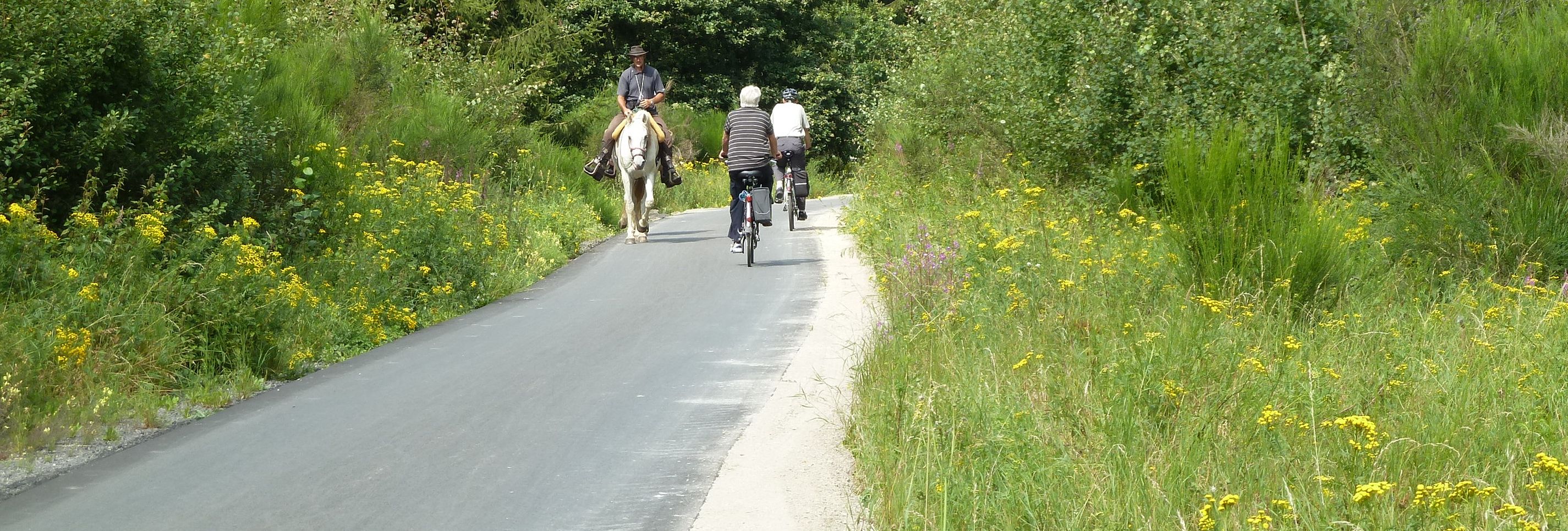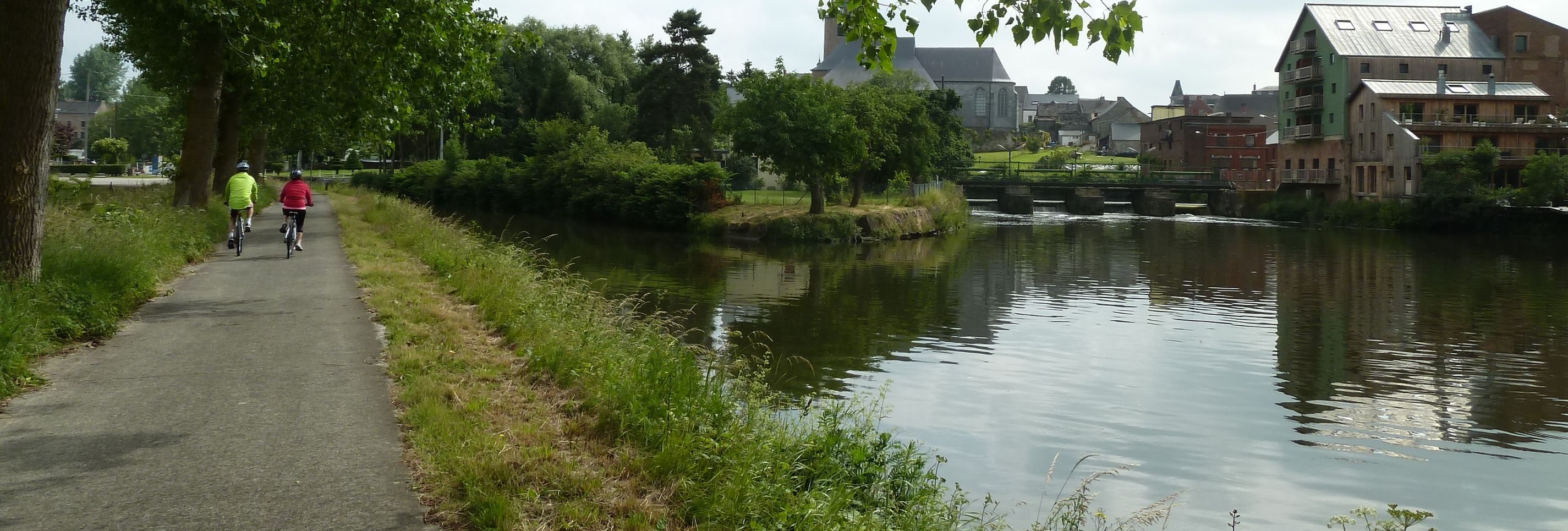Find my route
FAQ
We think we know everything about the RAVeL… but do we? Here is our FAQ intended to cover minor omissions, provide precise details, sometimes avoid having to wait for an answer, focus our thoughts more clearly, etc.
Is the RAVeL a cycle path?
-
No. The RAVeL is a network of public paths managed by the Walloon Region and reserved for walkers, cyclists and horse riders. The traffic on the RAVeL is governed by Article 22quinquies of the Highway Code.
A cycle path refers to the part of the public highway reserved for bicycles and category A two-wheeled mopeds indicated by the signs D7 or D9 or by the road markings laid down in Article 74 of the Highway Code.
Is the entire RAVeL accessible to horse riders?
-
No.
The traffic on the RAVeL is governed by Article 22quinquies of the Highway Code relating to traffic on paths reserved for walkers, cyclists and horse riders. “Only the categories of users whose symbol is indicated on the F99a or F99b signs placed at the access are permitted on these paths.” So only those sections of the RAVeL marked by the signs F99a or F99b including the horse rider symbol are accessible to horse riders. For safety reasons, for example, the sections of the RAVeL laid out along towpaths or which are narrow are usually forbidden to horse riders. Note that teams of horses are officially not authorised on the RAVeL.
What about people with reduced mobility?
-
"People pushing a wheelbarrow, a pushchair, a wheelchair or any other non-motorised vehicle that does not require a space wider than that necessary for walkers and those riding a bicycle, or motorised bicycle or a two-wheeled moped are equated to walkers".
Are all motorised vehicles forbidden on the RAVeL?
- Normally, yes.
Although the principle behind the RAVeL is to provide paths free of motorised vehicles, these are not banned across the entire network. Some exceptions are provided for by Article 22quinquies of the Highway Code:
“However, the following also may take these paths:
- priority vehicles (police cars, ambulances, fire engines), when justified by the nature of their mission;
- vehicles with authorisation issued by the manager of these paths, under conditions set by him:
- the vehicles used to survey, monitor and maintain these paths;
- the vehicles of local residents and their suppliers;
- vehicles used to collect refuse."
Remember that "the speed limit on the RAVeL is 30 km".
Are electric bicycles authorised on the RAVeL?
-
On the RAVeL, the walker and cyclist symbols are always indicated on the F99a or F99b signs that mark them. So walkers and cyclists are always authorised on the RAVeL.
The term ‘cycle’ is defined in Article 2.15.1 of the Highway Code as "any vehicles with two wheels or more, propelled by means of pedals or cranks by one or more of its passengers and without an engine, such as a bicycle, a tricycle or a quadricycle. The addition of an auxiliary electric engine with a maximum constant nominal capacity of 0.25 kW, whose power supply is gradually reduced and eventually cut off when the vehicle reaches a speed of 25 km/h, or earlier if the rider stops pedalling, does not modify the classification of the machine as a cycle." If the electric bicycle meets these criteria, it is authorised on the RAVeL.
Are tricycles and quadricycles (cuistax) authorised on the RAVeL?
-
No, because tricycles and quadricycles are not mentioned in Article 22quinquies of the Highway Code, unlike Article 22octies (paths reserved for farm vehicles). However, if the tricycles and quadricycles are less than one metre wide, they may be equated to bicycles and may therefore circulate on the RAVeL. This is logical; if they were any wider, they would inconvenience other users (passing one another, etc.).
Are speed pedelecs authorised on the RAVeL?
-
No, because the speed pedelec symbol is not included on the F99a or F99b signs marking a section of the RAVeL. In addition, speed pedelecs risk endangering or annoying the other RAVeL users, which is contrary to Article 22quinquies of the Highway Code.
Are segways, electric scooters and electric wheelchairs authorised on the RAVeL?
- Segways, electric scooters and electric wheelchairs are authorised on the RAVeL provided they are no more than one metre wide and their maximum speed is 25 km/h.
Can my dog come with me on the RAVeL?
-
Yes... as long as you keep it on a leash and abide by the municipal regulations, in particular those relating to ‘dangerous dogs’.
In addition, remember that you will have to gather up its dog mess or you will be fined. You also have to take all the precautions necessary to prevent your dog inconveniencing other users and affecting public safety.
Can the RAVeL be closed?
-
Yes, if emergency work has to be carried out, the surface has to be renovated or work is necessary on a civil engineering structure or infrastructure in the vicinity. Moreover, if the mayor of the commune through which the RAVeL passes considers that there is a risk to public safety on a path like the RAVeL during an event, he can exceptionally take responsibility for temporarily closing this path by means of a police order. In any case, the period of closure is limited to the time strictly necessary for the intervention and detour signs must be put in place by the party requesting the closure.
The RAVeL and hunting
-
Article 13 of the Forest Code stipulates that the RAVeL paths cannot be closed to public traffic for hunting purposes. They therefore have to remain open. The DGO1, the Mobility and Infrastructure Department of the Walloon Public Service, supports this principle.
The RAVeL therefore remains open during the hunting season but for your safety, do not leave the RAVeL track when hunting is underway in the surrounding area. This is usually indicated on a panel bearing the dates of the hunts and the symbol of a hunter on a yellow background . If the hunter symbol is on a red background
. If the hunter symbol is on a red background , the way is closed.
, the way is closed.
If I encounter a problem on the RAVeL (vegetation not properly maintained, rubbish, damaged surface or signs, dangerous spots, etc.), who should I tell?
-
You can send an e-mail to ravel.dgo1@spw.wallonie.be.
Is the RAVeL waymarked?
-
Yes, largely. Only the following sections of the RAVeL are not yet signposted/waymarked: RAVeL de la Lys, Charleroi - Historic Brussels Canal and the Lacs de l'Eau d'Heure. However, work is in progress to cover the entire network.
More information on signs and waymarking.
Where can I get paper maps of the RAVeL?
-
As a reminder, the general RAVeL map and the RAVeL maps on paper, which cover each of the five provinces of Wallonia, are available free of charge. You can order these maps on the page Guides and maps/Map order form.
The page Guides and maps also gives the references to other maps produced by our partners.
Finally, we are in regular contact with most of the Tourist Boards and Information Services, Tourist Offices, etc., as well as with establishments that have the ‘Bikes Welcome’ label. The RAVeL maps are also available here free of charge!
Is it possible to download the GPS/GPX files of the routes?
-
Yes. On the page of each stage along a route, you will find the GPS/GPX file corresponding to the path followed by the stage. Simply click on the GPS/GPX button to download it.
Where can I obtain tourist information (accommodation, sites to visit, bike hire, etc.)?
-
On this website, in the description of the stages of each route, you will find a list of accommodation, restaurants, sights and places of interest, tourist reception points and bicycle hire points located less than three kilometres from the route selected. Operators with the ‘Bikes Welcome’ label appear at the top of the list. The ‘Bikes Welcome’ label aims to boost and improve the quality of the welcome around the RAVeL or other cycling paths by offering services and equipment adapted to the specific needs and expectations of cycle tourists. If you would like more tourist information, we advise you to consult the website walloniebelgiquetourisme.be, the websites of the five Provincial tourism federations or the Tourist Boards of Wallonia.
Is there a nodal-points network system in Wallonia like the one in Flanders or the Netherlands?
-
Yes. You will find the information by clicking here.










